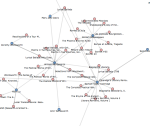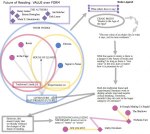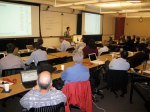RoSE is an online exploration environment for humanities students and researchers modeled as a dynamic “social network” of authors and works, past or present. It presents bibliographical information on the human record as an interconnected network of evolving relationships between, for example, an author’s influences, friends, and collaborators; or an author’s or intellectual movement’s works in their interconnections. RoSE allows users to add items to the network, visualize the results, make collections of resources, and create storyboards to organize their findings into meaningful arguments or narratives. (RoSE also facilitates finding full texts or other information about the resource online, but it does not contain the full texts themselves.)
In essence, RoSE is a discovery tool. When beginning to do research or thinking on an author, work, or movement, users can explore RoSE to see what the interesting clusters and pathways of relationship are that might suggest interpretations and theses.
Underlying RoSE is the question: what do users want when they begin online research or learning on a humanistic topic? RoSE’s answer is that users do not necessarily want to go first to a document (a “document-centric” approach) or to a person (a “social-network” approach)–though they will take either. More ideal is an environment that allows them to seek out documents and people in the context of relationships between the two (e.g., of authorship, influence, sponsorship, commentary, rebuttal, etc.). In such an environment, there are no documents sitting in virtual libraries as opposed to people joining communities. Instead, documents, authors, editors, readers, scholars, and so on are interlinked in a single environment, conjoining the paradigm of an archive with that of the social network.
Through profile pages about both people and documents, keywords, and visualizations, RoSE helps users see the evolving relationships between people-and-documents, people-and-people, and documents-and-documents. RoSE also accommodates more complex user-created association types than allowed by standard metadata protocols (e.g., controlled vocabularies for “author of,” “friend of”), which allows users to add many layers of complexity to relationships in the system.
RoSE first evolved as an experiment of the University of California multi-campus “Transliteracies Project” on online reading (2005-2010: http://transliteracies.english.ucsb.edu). A total of 61 faculty, 40 graduate students, and 7 industry professionals from 31 programs and 35 institutions contributed to conferences, workshops, and a “Social Computing in 2020” innovation contest. In its first years, the project’s working groups (on history of reading, new reading interfaces, and social computing) conducted an extensive environmental scan that produced 78 online research reports and 7 fuller research papers (see Transliteracies site). In its final year, the project then focused on an under-examined area: social-computing technologies bridging integrally between humanities and Web 2.0 online environments. Working with graduate students in the humanities, media arts, and engineering in biweekly developer meetings (which doubled as de facto seminars on fascinating blends of technical and conceptual issues), we devoted 2009-10 to creating the RoSE prototype, which was presented for initial critique at a Feb. 2010 “design charrette” attended by 16 UC faculty and respondents from industry and other universities.
Subsequently, work on RoSE continued in 2011-12 through a NEH Digital Humanities Start-up grant (level II). This grant allowed the project team to concentrate on improving usability, harvesting additional data with which to stock the system (including from the Social Networks & Archival Context [SNAC] project), creating new functions (e.g., the “Story board”), and test the system in a number of use-scenarios (including use by undergraduates in a classroom assignment).
Current State of RoSE Project:
RoSE is a demonstration project under development. At the present time, full access to the system (including editing rights) is restricted to invited participants, though a guest account is available for others interested in exploring the system (click on “Log in” without entering a password for the guest account).
Technical Description of RoSE:
RoSE is a Web-accessible system developed in the open-source Ruby on Rails programming environment (http://rubyonrails.org/) on top of a MySQL relational database. It uses the open-source Adobe Flex framework (http://www.adobe.com/products/flex/) with the Flare library (http://flare.prefuse.org/) for visualizations. Currently, it is pre-loaded with metadata about persons and documents text-mined from the YAGO knowledge base (http://www.mpi-inf.mpg.de/yago-naga/yago/; data about 6,756 people, 10,703 docs); Project Gutenberg (http://www.gutenberg.org/; data about 11,921 people, 32,996 docs); the Social Networks & Archival Contexts project (SNAC) (http://socialarchive.iath.virginia.edu/), plus datasets manually entered by users.



